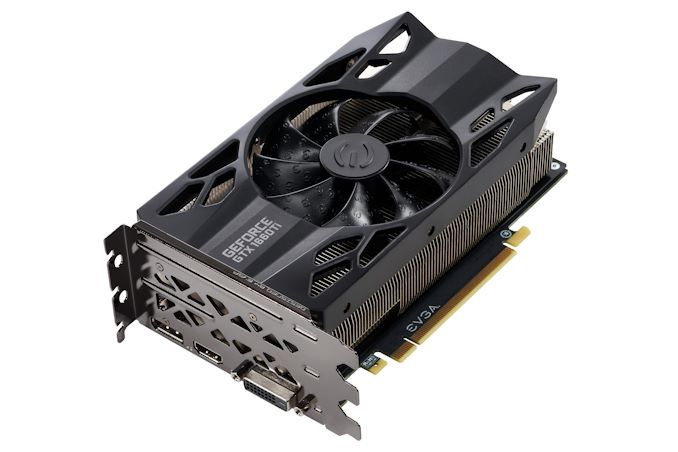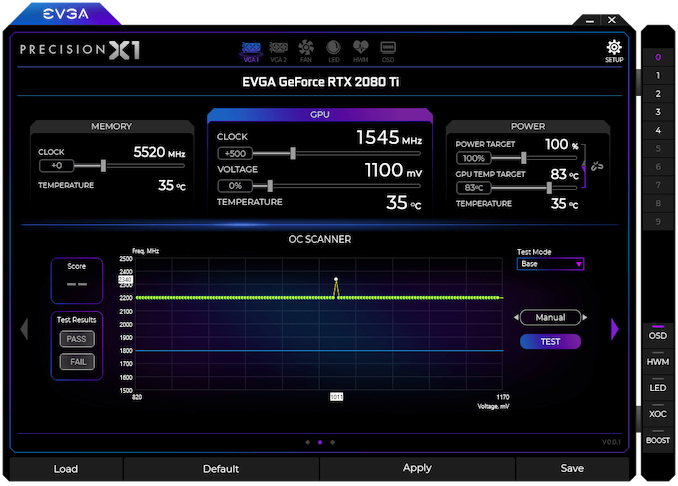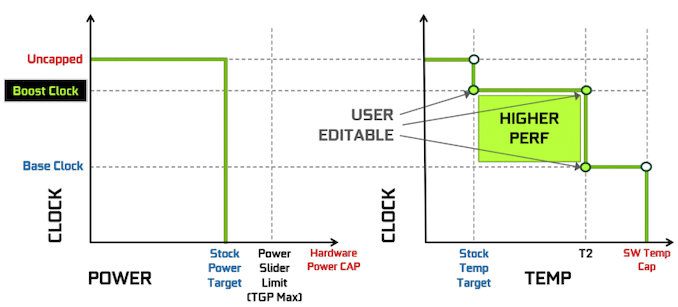The NVIDIA GeForce GTX 1660 Ti Review, Feat. EVGA XC GAMING: Turing Sheds RTX for the Mainstream Market
by Ryan Smith & Nate Oh on February 22, 2019 9:00 AM ESTMeet The EVGA GeForce GTX 1660 Ti XC Black GAMING
As a pure virtual launch, the release of the GeForce GTX 1660 Ti does not bring any Founders Edition model, and so everything is in the hands of NVIDIA’s add-in board partners. For today, we look at EVGA’s GeForce GTX 1660 Ti XC Black, a 2.75-slot single-fan card with reference clocks and a slightly increased TDP of 130W.
| GeForce GTX 1660 Ti Card Comparison | ||||
| GTX 1660 Ti Ref Spec | EVGA GTX 1660 Ti XC Black GAMING | |||
| Base Clock | 1500MHz | 1500MHz | ||
| Boost Clock | 1770MHz | 1770MHz | ||
| Memory Clock | 12Gbps GDDR6 | 12Gbps GDDR6 | ||
| VRAM | 6GB | 6GB | ||
| TDP | 120W | 130W | ||
| Length | N/A | 7.48" | ||
| Width | N/A | 2.75-Slot | ||
| Cooler Type | N/A | Open Air | ||
| Price | $279 | $279 | ||
Seeing as the GTX 1660 Ti is intended to replace the GTX 1060 6GB, EVGA’s cooler and card design is new and improved compared to their Pascal cards, and was first introduced with the RTX 20-series as they rolled out the iCX2 cooling design and new “XC” card branding, complementing their existing SC and Gaming series. As we’ve seen before, the iCX platform is comprised of a medley of features, and some of the core technology is utilized even when the full iCX suite isn’t. For one, EVGA reworked their cooler design with hydraulic dynamic bearing (HDB) fans, offering lower noise and higher lifespan than sleeve and ball bearing types, and this is present in the EVGA GTX 1660 Ti XC Black.
In general, the card essentially shares the design of the RTX 2060 XC, complete with those new raised EVGA ‘E’s on the fans, intended to improve slipstream. The single-fan RTX 2060 XC was paired with a thinner dual-fan XC Ultra variant, and in the same vein the GTX 1660 Ti XC Black is a one-fan design that essentially occupies three slots due to the thick heatsink and correspondingly taller fan hub. Being so short, though, makes the size a natural fit for mini-ITX form factors.
As one of the cards lower down the RTX 20 and now GTX 16 series stack, the GTX 1660 Ti XC Black also lacks LEDs and zero-dB fan capability, where fans turn off completely at low idle temperatures. The former is an eternal matter of taste, as opposed to the practicality of the latter, but both tend to be perks of premium models and/or higher-end GPUs. Putting price aside for the moment, the reference-clocked GTX 1660 Ti and RTX 2060 XC Black editions are the more mainstream variant anyhow.
Otherwise, the GTX 1660 Ti XC Black unsurprisingly lacks a USB-C/VirtualLink output, offering up the mainstream-friendly 1x DisplayPort/1x HDMI/1x DVI setup. Although the TU116 GPU still supports VirtualLink, the decision to implement it is up to partners; the feature is less applicable for cards further down the stack, where cards are more sensitive to cost and are less likely to be used for VR. Additionally, the 30W USB-C controller power budget could be significant amount relative to the overall TDP.
And on the topic of power, the GTX 1660 Ti XC Black’s power limit is actually capped at the default 130W, though theoretically the card’s single 8-pin PCIe power connector could supply 150W on its own.
The rest of the other GPU-tweaking knobs are there for your overclocking needs, and for EVGA this goes hand-in-hand with Precision, their overclocking utility. For NVIDIA’s Turing cards, EVGA released Precision X1, which allows modifying the voltage-frequency curve and scanning for auto-overclocking as part of Turing’s GPU Boost 4. Of course, NVIDIA’s restriction of actual overvolting is still in place, and for Turing there is a cap at 1.068v.
















157 Comments
View All Comments
Rudde - Friday, February 22, 2019 - link
Never mind, the second page explains this well. (Parallell execution of fp16, fp32 and int32)CiccioB - Saturday, February 23, 2019 - link
Not only that.With Turing you also get mesh shading and a better support for thread switching, which is a awful technique used on GCN to improve its terrible efficiency, having lots of "bubbles" in the pipelines.
That's the reason you see previous AMD optimized games that didn't run too well with Pascal work much better with Turing, as the high threaded technique (the famous AC which is a bit overused in engines created for the console HW) is not going to constantly stall the SM with useless work as that of frequent task switching.
AciMars - Saturday, February 23, 2019 - link
“Worse yet, the space used per SM has gotten worse“. not true.. you know, turing have separate cuda cores for int and fp. It means when turing have 1536 cuda cores means 1536 int + 1536 fp cores. So on die size actually turing have 2x cuda cores compare to pascalCiccioB - Monday, February 25, 2019 - link
Not exactly, the number of CUDA core are the same, just that a new independent ALU as been added.A CUDA core is not only an execution unit, it also registers, memory (cache), buses (memory access) and other special execution units (load/store).
By adding a new integer ALU you don't automatically get double the capacity as really doubling the number of a complete CUDA core.
ballsystemlord - Friday, February 22, 2019 - link
Here are some spelling and grammar corrections.This has proven to be one of NVIDIA's bigger advantages over AMD, an continues to allow them to get away with less memory bandwidth than we'd otherwise expect some of their GPUs to need.
Missing d as in "and":
This has proven to be one of NVIDIA's bigger advantages over AMD, and continues to allow them to get away with less memory bandwidth than we'd otherwise expect some of their GPUs to need.
so we've only seen a handful of games implement (such as Wolfenstein II) implement it thus far.
Double implement, 1 befor ()s and 1 after:
so we've only seen a handful of games (such as Wolfenstein II) implement it thus far.
For our games, these results is actually the closest the RX 590 can get to the GTX 1660 Ti,
Use "are" not "is":
For our games, these results are actually the closest the RX 590 can get to the GTX 1660 Ti,
This test offers a slew of additional tests - many of which use behind the scenes or in our earlier architectural analysis - but for now we'll stick to simple pixel and texel fillrates.
Missing "we" (I suspect that the sentence should be reconstructed without the "-"s, but I'm not that good.):
This test offers a slew of additional tests - many of which we use behind the scenes or in our earlier architectural analysis - but for now we'll stick to simple pixel and texel fillrates.
"Looking at temperatures, there are no big surprises here. EVGA seems to have tuned their card for cooling, and as a result the large, 2.75-slot card reports some of the lowest numbers in our charts, including a 67C under FurMark when the card is capped at the reference spec GTX 1660 Ti's 120W limit."
I think this could be clarified as their are 2 EVGA cards in the charts and the one at 67C is not explicitly labeled as EVGA.
Thanks
Ryan Smith - Saturday, February 23, 2019 - link
Thanks!boozed - Friday, February 22, 2019 - link
The model numbers have become quite confusingYojimbo - Saturday, February 23, 2019 - link
I don't think they are confusing, 16 is between 10 and 20, plus the RTX is extra differentiation. In fact if NVIDIA had some cards in the 20 series with RTX capability and some cards in 20 series without RTX capability, even if some were 'GTX' and some were 'RTX', then that would be far more confusing. Putting the non-RTX Turing cards in their own series is a way of avoiding confusion. But if they actually come out with an "1180" as say some rumors floating around, that would be very confusing.haukionkannel - Saturday, February 23, 2019 - link
Interesting to see the next year.Rtx 3050 and gtx 2650ti for the weaker version, if we get one new card rtx family... Hmm... that could work if They keep the naming. 2021 RTX3040 and gtx 2640ti...
CiccioB - Thursday, February 28, 2019 - link
Next generation all cards will have enough RT and tensor core enabled.